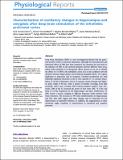Por favor, use este identificador para citar o enlazar a este item:
http://hdl.handle.net/10261/164461COMPARTIR / EXPORTAR:
 SHARE SHARE
 CORE
BASE CORE
BASE
|
|
| Visualizar otros formatos: MARC | Dublin Core | RDF | ORE | MODS | METS | DIDL | DATACITE | |

| Título: | Characterization of oscillatory changes in hippocampus and amygdala after deep brain stimulation of the infralimbic prefrontal cortex |
Autor: | Cervera-Ferri, Ana; Teruel-Martí, Vicent; Barceló-Molina, Moises; Martínez-Ricós, Joana; Luque-García, Aina; Martínez-Bellver, Sergio; Adell, Albert CSIC ORCID | Palabras clave: | Mutual information Modulatory index Local field potential Brain oscillations Antidepressant |
Fecha de publicación: | 2016 | Editor: | John Wiley & Sons Physiological Society (Great Britain) American Physiological Society |
Citación: | Physiological Reports 4(14): e12854 (2016) | Resumen: | Deep brain stimulation (DBS) is a new investigational therapy that has generated positive results in refractory depression. Although the neurochemical and behavioral effects of DBS have been examined, less attention has been paid to the influence of DBS on the network dynamics between different brain areas, which could contribute to its therapeutic effects. Herein, we set out to identify the effects of 1 h DBS in the infralimbic cortex (IL) on the oscillatory network dynamics between hippocampus and basolateral amygdala (BLA), two regions implicated in depression and its treatment. Urethane-anesthetized rats with bilaterally implanted electrodes in the IL were exposed to 1 h constant stimulation of 130 Hz of frequency, 60 μA of constant current intensity and biphasic pulse width of 80 μsec. After a period of baseline recording, local field potentials (LFP) were recorded with formvar-insulated stainless steel electrodes. DBS of the IL increased the power of slow wave (SW, <1.5 Hz) and theta (3–12 Hz) frequencies in the hippocampus and BLA. Furthermore, IL DBS caused a precise coupling in different frequency bands between both brain structures. The increases in SW band synchronization in hippocampus and BLA after DBS suggest that these changes may be important for the improvement of depressive behavior. In addition, the augmentation in theta synchrony might contribute to improvement in emotional and cognitive processes. | Versión del editor: | https://doi.org/10.14814/phy2.12854 | URI: | http://hdl.handle.net/10261/164461 | DOI: | 10.14814/phy2.12854 | Identificadores: | doi: 10.14814/phy2.12854 e-issn: 2051-817X |
| Aparece en las colecciones: | (IBBTEC) Artículos |
Ficheros en este ítem:
| Fichero | Descripción | Tamaño | Formato | |
|---|---|---|---|---|
| chaprecortex.pdf | 2,41 MB | Adobe PDF |  Visualizar/Abrir |
CORE Recommender
PubMed Central
Citations
7
checked on 10-abr-2024
SCOPUSTM
Citations
14
checked on 17-abr-2024
WEB OF SCIENCETM
Citations
12
checked on 22-ene-2024
Page view(s)
302
checked on 18-abr-2024
Download(s)
212
checked on 18-abr-2024

